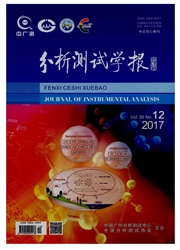

 中文摘要:
中文摘要:
基于急性早幼粒细胞白血病(APL)中PML/RARa融合基因的碱基序列,设计了新型的锁核酸(LNA)修饰寡核苷酸作为捕获探针和信号探针,研究出一种基于“三明治”传感模式的电化学生物传感器对PML/RARa融合相关基因进行检测。靶序列分别与捕获探针和信号探针杂交后形成“三明治”结构。将修饰电极置于含有底物3,3’,5,5'-四甲基联苯胺(TMB)和过氧化氢的测定溶液中,用计时电流法检测靶序列。结果表明,该传感器可定量识别和检测溶液中人工合成的短链APLPML/RARa融合基因片段。经过条件优化,杂交前后电流值与靶标链浓度在1.0×10^-12 -2.5×10^-11mol/L范围内呈良好的线性关系,检出限为8.5×10^-13mol/L。该方法简单、特异性好,有望用于实际样品的检测。
 英文摘要:
英文摘要:
A new kind of sandwich-type DNA electrochemical biosensor is designed to detect PML/ RARα fusion gene in acute promyelocytic leukemia. This biosensor is based on a "sandwich" detection strategy, in which involves a pair of locked nucleic acids (LNA) modified oligonucleotides as probes, including capture probe DNAs and reporter probe DNAs, both of which contain complementary sequences to one end of the target DNA. An enzymatically amplified electrochemical current signal was observed when the biosensor was used for detection of target DNA in sample containing 3, 3', 5, 5'-tetramethylbenzidine(TMB) and H2o2 substrate. The results indicate that, under the optimal conditions, the relationship between amperometric current and the concentration of synthetic target DNA complementary strand is linear in the range of 1.0×10^ -12 -2. 5 × 10^-11 mol/L with a detection limit of 8.5 ×10 ^-13 mol/L. The method show good simplicity and specificity, and is expected to be used in real sample.
 同期刊论文项目
同期刊论文项目
 同项目期刊论文
同项目期刊论文
 Electrochemical biosensor based on nanogold-modified poly-eriochrome black T film for BCR/ABL fusion
Electrochemical biosensor based on nanogold-modified poly-eriochrome black T film for BCR/ABL fusion Simultaneous Voltammetric Determination of Ascorbic Acid, Dopamine and Uric Acid Using Polybromothym
Simultaneous Voltammetric Determination of Ascorbic Acid, Dopamine and Uric Acid Using Polybromothym 期刊信息
期刊信息
